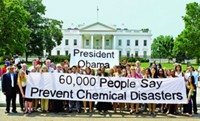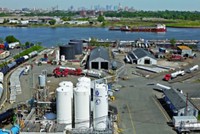Advertisement
Grab your lab coat. Let's get started
Welcome!
Welcome!
Create an account below to get 6 C&EN articles per month, receive newsletters and more - all free.
It seems this is your first time logging in online. Please enter the following information to continue.
As an ACS member you automatically get access to this site. All we need is few more details to create your reading experience.
Not you? Sign in with a different account.
Not you? Sign in with a different account.
ERROR 1
ERROR 1
ERROR 2
ERROR 2
ERROR 2
ERROR 2
ERROR 2
Password and Confirm password must match.
If you have an ACS member number, please enter it here so we can link this account to your membership. (optional)
ERROR 2
ACS values your privacy. By submitting your information, you are gaining access to C&EN and subscribing to our weekly newsletter. We use the information you provide to make your reading experience better, and we will never sell your data to third party members.
Policy
Inherently Safer
by Rudy M. Baum
November 23, 2009
| A version of this story appeared in
Volume 87, Issue 47
AS REPORTED IN last week's issue of C&EN (page 6), the House of Representatives has passed legislation that "would significantly expand the Department of Homeland Security's (DHS) authority to regulate security practices at thousands of facilities nationwide that produce, use, or store chemicals."
The American Chemical Society worked to ensure that the Chemical & Water Security Act of 2009 (H.R. 2868) was structured in a way that advanced innovation and safety. In taking this position, ACS parted company to some extent with chemical industry trade associations like the Society of Chemical Manufacturers & Affiliates, which represents primarily small- and medium-sized batch chemical manufacturers. SOCMA and other trade groups oppose H.R. 2868 because, among other provisions, it gives DHS the authority to require implementation of inherently safer technologies (IST) to reduce the potential consequences of a terrorist attack.
IST mandated by a federal agency is anathema to the chemical industry. The industry argues that it already incorporates the principles of IST into its design of processes and plants and that it is in a much better position to balance risks and improve safety than is a government official. The industry fears that some chemicals essential to certain processes will be banned because they are perceived as highly toxic and dangerous. It also argues that an IST mandate will result in negative, unintended consequences, such as product shortages.
In the lead-up to the House vote on the bill, a number of compromises were struck. Only companies in the so-called Tier 1 and Tier 2 risk categories—the riskiest of four tiers—are covered by the IST mandate. The bill instructs DHS to establish separate standards and procedures for academic labs, a provision supported by ACS.
Some industry representatives are upset with ACS's effort to include IST in the legislation constructively and in a manner consistent with the society's position on IST. The groups believe that ACS should have joined industry in presenting a unified position on IST to Congress.
ACS has a position on IST expressed in a public policy statement adopted in 2006 that is both fairly nuanced and entirely consistent with its efforts on H.R. 2868.
It states: "Inherently safer industrial technologies for the production, transport, and use of industrial and agricultural chemicals, pharmaceuticals, and both commodity and advanced materials is a vital concept. ... While many industrial processes and sectors use various definitions of this term, collectively, they capture a group of processes and technologies that improve safety by greatly reducing or eliminating hazards through a permanent and inseparable element of the process. Thus, safety is built into the process, not added on, and hazards are reduced or eliminated, not simply controlled."
It also states, however, that IST "is only one of many approaches that may be employed to achieve risk reduction. A successful approach to changing technology in this area will come about through a holistic application of safety analysis that extends from the top to the bottom of the organization, designing safer systems which include safer practices and an organizational prejudice toward safety."
The letter that went out to the society's Legislative Action Network members on H.R. 2868 recognizes the challenges of implementing an IST mandate. It states: "Careful application of IST options raises multiple technical issues and requires considerable effort to develop, scale-up, test, and install new, safer procedures, and to ensure that the new processes do not create inferior products or unforeseen health, safety, or environmental impacts."
Chemical safety expert Neal Langerman testified on behalf of ACS on H.R. 2868 in June. He stated that "application of IST is a complex and nuanced process. Professionals need to apply these principles and processes where appropriate." He provided examples to illustrate the complexity involved in successfully implementing IST.
I understand the chemical industry's concerns about H.R. 2868. However, I also think ACS has got it just about right on IST.
Thanks for reading.
Rudy Baum
Editor-in-chief
Views expressed on this page are those of the author and not necessarily those of ACS.




Join the conversation
Contact the reporter
Submit a Letter to the Editor for publication
Engage with us on Twitter